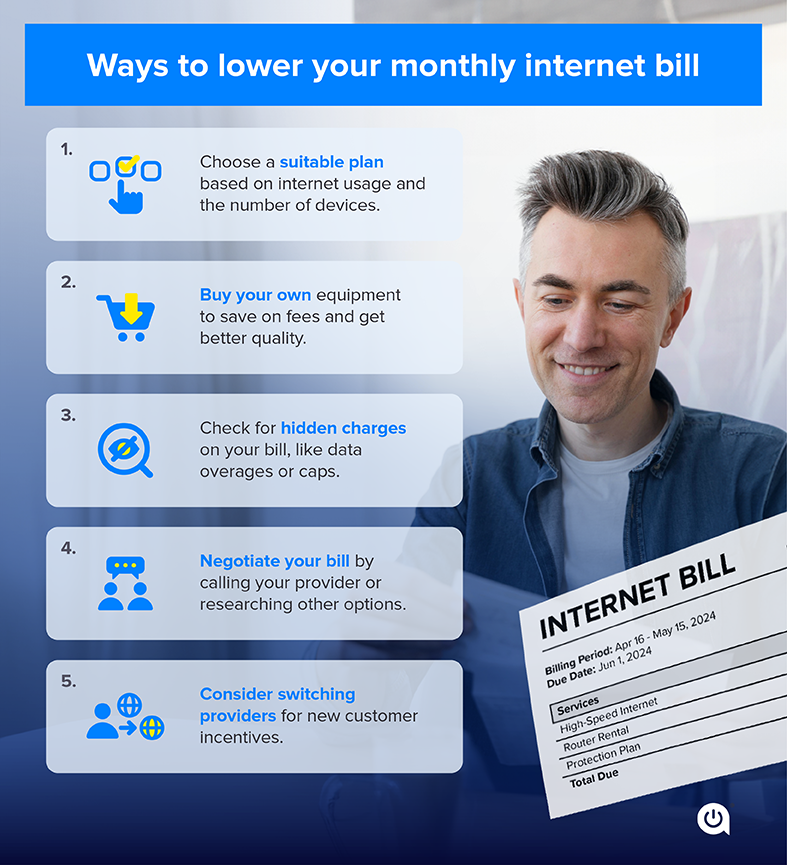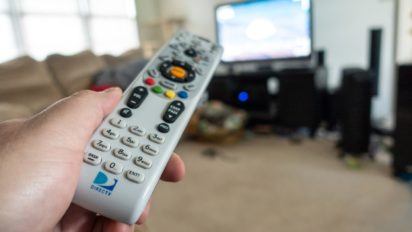Key findings
- The average price of internet plans offered in the U.S. is $92.22/mo.
- Most people opt for cheaper plans. The median price paid for internet in the U.S. is between $75 and $89/mo.
- Satellite has the highest average plan price at $99.99/mo., followed by fiber ($92.75/mo.), cable ($91.89/mo.), and wireless ($62.00/mo.).
- Only 24% of internet providers require you to commit to a term contract for service.
- 78% of Americans say the internet is as important as electricity and water.
Once a luxury, high-speed internet service has become a utility nearly as commonplace and essential in homes as power or water. In fact, Consumer Reports surveyed Americans on internet accessibility and found that “78% of respondents say that they agree that Internet is as important as electricity and water.”
As such, you can plan on fitting internet somewhere in your monthly budget, but just how much should you be allocating for it?
How much does internet cost per month?
The average price of internet plans offered in the U.S. is $92.22/mo., according to an Allconnect analysis of more than 250 plans from the country’s top internet providers.
However, most consumers opt for cheaper plans. The median price for internet in the U.S. is $74.99/mo., according to Consumer Reports. About half of all households pay between $60 and $90 monthly. U.S News and World Report clock the average cost at around $89/mo.
On average, U.S. households are paying around $900 a year for internet service.
Another way to look at it is by speed. The average plan available in the U.S. provides 480 Mbps of download speed, while the average speed people actually receive is over 249 Mbps.
Verizon conducted a survey that revealed that 51 million Americans do not know how much they pay for internet per month. In fact, some incorrectly estimated what they pay at about five times higher than most internet plans actually cost.
Internet costs broken down by internet type
Although customers with DSL paid the least for their service, they also did not receive speeds as fast as they did with cable or fiber optic. DSL and satellite are more popular in rural areas where cable and fiber aren’t yet available.
Average price and speed offered by each provider
For most providers, the average speed that they offer in their plans is far higher than most people subscribe to — particularly for cable and fiber providers. The average plan from WOW!, for instance, is well above 1,000 Mbps. Satellite providers like HughesNet and Viasat, on the other hand, offer an astronomical price per Mbps of $2.80 and $2.57 respectively.
Average price by download speed
Unsurprisingly, the price per Mbps provided by each plan goes down as speeds go up, but what’s less intuitive is how the average starting prices for 800 Mbps plan ($63.33/mo.) is actually cheaper than for a 25 Mbps plan ($79.16/mo.). Typically the only providers who offer plans as low as 25 Mbps are satellite or DSL providers. In other words, they’re the only game in town and they can be prohibitively expensive. Fiber and cable plans are actually cheaper for all plans except the very fastest speeds.
Contract length
As internet competition has improved in the past decade, one benefit consumers have seen is the phasing out of term contracts. These days, only 24% of internet providers require you to sign a contract, and 13% of them are satellite internet companies. For the rest, you can switch your service any time you want without incurring early termination fees.
Top internet provider plans and pricing
| Provider | Price range | Download speed range |
|---|---|---|
AT&T internet | $55.00 – $180.00/mo. | 10 – 4,700 Mbps |
CenturyLink internet | $50.00 – $75.00/mo. | 100 – 940 Mbps |
Cox internet | $50.00 – $150.00/mo. | 100 – 2,000 Mbps |
Frontier Fiber internet | $29.99 – $154.99/mo. | 500 – 5,000 Mbps |
Hughesnet | $49.99 – $94.99/mo. | Up to 100 Mbps |
Spectrum internet | $49.99 – $79.99/mo. | 300 – 1,000 Mbps** |
 Verizon Verizon | $49.99 – $109.99/mo. | 300 – 2,000 Mbps |
Xfinity internet | $24.99 – $299.95/mo. | 50 – 6,000 Mbps |
*Pricing per month plus taxes for length of contract. Additional fees and terms may apply. Pricing varies by location and availability. All prices subject to change at any time. May or may not be available based on service address. Speeds may vary. As of 06/21/24.
**Wireless speeds may vary.
What added fees do internet providers charge?
As with many services, the initial price you see for internet is not exactly what you can expect to pay. Fees will vary by provider, but some of the added costs that could inflate your bill include:
- Equipment rental – Modem and router rentals can add $10-$20/mo. to your internet bill. Some providers may include equipment at no extra cost, especially with their higher-tiered plans. Others may allow you to use your own compatible equipment to avoid paying the equipment rental fee.
- Installation/activation fees – Installation costs are thankfully one-time fees, but they can add $100 or more to the initial cost of internet. Many providers waive the installation fee for new customers or offer self-installation at a reduced cost. In addition to the installation fee, an activation fee may also apply.
- FCC Universal Service Fund fee – The FCC charges internet providers a quarterly fee to help fund the expansion of broadband access to rural and low-income areas. Internet providers often pass these fees on to their customers. The fees typically aren’t much, around $5/mo. or less, but the exact fee will vary by provider.
- Late payment fee – Penalties for late payments vary from state to state, but you could be charged a percentage of your bill or a set fee of $20 or higher for late fees. And if your internet service is disconnected due to non-payment, you may be charged an additional fee to restore service.
- Cancelation fee – Terminating service before the end of your contract can levy high cancelation fees. Most internet providers prorate early termination fees depending on how many months are left on your contract and may charge hundreds of dollars for opting out of your service. Some providers, such as CenturyLink, Spectrum and Verizon do not require annual service agreements, so you don’t have to worry about early termination fees.
- Data overage fee – If your provider does not offer unlimited data, then you may run into charges for going over your monthly data allowance. Most providers charge $10 for every 50 GB you go over your data cap.
Even if your internet provider does not charge added monthly or one-time fees, regional and federal taxes will add to your monthly internet costs. Check out our guide to internet fees for more information about internet fees from specific providers.
Why does internet cost so much?
Equipment and installation: One of the main reasons internet prices run high is the cost of equipment and installation in new service areas. Fiber optic cables are expensive, so fiber optic internet providers may have higher prices to recoup the costs of installing new lines. The same goes for satellite internet — those satellites aren’t cheap. This is also why DSL internet, which uses existing phone lines to deliver service, is commonly one of the cheaper internet options.
Speed capabilities: The plan you choose also has much to do with how much you pay for internet. More often than not the faster a plan is, the more it will cost. Cable and fiber optic internet often give you the most speed choices, so these two service types will have some of the highest-priced plans, should you opt for faster speeds.
Hidden fees: Of course, as with any home service, you can expect fees and hidden costs to factor into your bill as well. Equipment rental fees, installation costs, Wi-Fi fees and data overages, if applicable, can inflate your monthly payment. Unfortunately, these fees often aren’t clearly stated in the advertised price, so it pays to do a little research before committing to a new internet service.
Lack of competition: One of the more frustrating reasons why internet often costs so much is that most internet providers don’t have any real competition in their areas. As a result, they can charge more than necessary. For instance, The ILSR reported in 2020 that at least 83.3 million Americans can only access broadband through a single provider.
Expert tip
Learn how the type of internet your home has can affect speed and reliability.
So how much should I be paying for internet?
Asking how much you should pay for high-speed internet is like asking how much you should pay for TV service. There’s no precise answer because it all depends on what you need.
For a basic internet package, you can expect average monthly costs of around $60 or less.
For high-speed internet packages at or over 100 Mbps, your bill will likely range from $60 to over $100/mo.
How to lower your monthly internet bill
A Consumer Reports survey noted that, “over a quarter of Americans (27%) who have a broadband service at their home say it’s somewhat or very difficult to afford their monthly broadband costs.”
Unfortunately, there isn’t one magic trick to lowering your internet bill, but there are several things you can try that can help save you money in the long term. First, determining what your internet needs are and finding a plan that best fits them is the best way to keep from overpaying for internet. Additionally, it will also help you avoid getting stuck in a plan you’re not happy with.

Pick a plan that fits your needs
The simplest way to lower your internet bill is to downgrade the speed you’re getting. Knowing what you use the internet for and how many connected people/devices you have in your home will help you choose the plan that best fits your needs. As a rule of thumb, most people can get by with about 25 Mbps of download speed for each person in their household.
Activities such as streaming in HD, gaming online and uploading to social media will require faster speeds, especially if you plan to connect multiple devices. Take our internet speed test to get an idea of what speeds you currently are using or check out our guide to internet speeds.
Need more for the price?
Try these helpful hacks to improve your internet speed. Or if you just want more bang for your buck, check out providers near you with more speed for the price. Either way, we’ll help you find what you need.
View providers near meRather chat? Give us a call: (844) 451-2720
Rather chat? Give us a call: (844) 451-2720Pro Tip: For best results, use an Ethernet cord to connect your router or modem directly to your device before you run the test.
Buy your own equipment
One of the easiest ways to save money on your internet bill is to buy your own modem and router. Equipment fees add around $10-20 to your monthly bill, while you can typically buy your own for around $100. That means the equipment usually pays for itself in the first year. Plus, the equipment you purchase on your own is often higher quality than what your provider rents to you.
A trend with some providers is that they are incorporating the equipment cost into the overall plan cost, so if you buy your own equipment in that case, you’d essentially be paying twice. Double-check if your provider offers no equipment fees – it might save you money in the long haul.
Check out the articles below for complete lists of modems and routers that work with each provider:
- Mediacom-compatible modems
- Windstream-compatible modems and routers
- Spectrum-compatible routers
- CenturyLink-compatible modems and routers
- Verizon-compatible routers
Look at hidden fees on your bill
If your internet bill is more than you expect every month, it might be time to go over it with a fine-tooth comb. You might be accruing extra charges you didn’t know about.
Data overages are something many of us don’t think about until we’ve unknowingly gone over the limit and got hit with a $50 fee. Many providers impose data caps, usually around 1TB per month (which is actually a lot of data) but some may have much lower caps. Often, the data cap varies not just by the provider, but also by the plan.
If you’re getting hit with these fees, you can monitor your data usage to ensure you stay under it going forward, or opt for an unlimited data plan. AT&T, Frontier, Spectrum, Verizon FiOS and Xfinity all offer unlimited data options with most plans.
Take advantage of government subsidies
If you utilize a government program like the Supplemental Nutrition Assistance Program (SNAP), Medicaid, or the free or reduced-price school breakfast/lunch program, you could be eligible for internet assistance programs like Connect2Compete or other ISP programs. Additionally, Lifeline provides a monthly subsidy of $9.25 towards your internet or phone bill based on similar eligibility guidelines.
Negotiate your bill
Call your internet provider and see if you can get a lower rate. It won’t always get you a lower price, but it can’t hurt to ask. To help your cause, be firm in your request and come with knowledge about what other providers in your area are offering.
Switch internet providers
If you tried the steps above, and your bill is still higher than you want, your only remaining option is to move to another provider. Many providers offer incentives for new customers including promotional pricing, contract buyouts or free streaming subscriptions when you sign up. Do a thorough search of internet providers in your area to see how these options compare to your current bill. Remember, your new bill will likely end up being about $15 more after fees than what’s advertised — especially if you’re renting equipment.
For researchers and journalists
If you would like to know more about this topic, we can assist you. Our experts can help you dig deeper into the data.
Email our expertsIn summary, get a plan that fits your needs and cut costs where you can
Which internet providers are available in your area plays a major role in how much you pay for internet, but you have control over which plans you pick and the extra costs you have to pay.
Choose a plan that best fits your speed requirements, then cut costs where you can by using your own equipment, keeping an eye on your data and re-evaluating your plan when your contract is up.
Rely on our internet experts for more tips on how to save on your internet costs, and to shop for the right internet plan for your home.
Internet cost FAQs
$100/mo. for an internet plan is a bit high for 1 to 2 people. You should be able to find a plan with the right speed for you under $80/mo. For larger homes with more users, expect to pay $100 or more.
You’ll need an internet plan to have a Wi-Fi network in your home. The average cost of an internet plan is about $75/mo., but some providers offer intro rates as low as $25/mo.
Allconnect: Let us compare providers for you
Why should you choose Allconnect? We’re the #1 broadband marketplace in the U.S, meaning you can trust us to search, compare and order internet and TV service for your home.
Get started

Written by:
Joe SupanPrincipal Writer, Broadband Content
Joe is a senior writer for CNET covering home technology and broadband. Prior to joining CNET, Joe led MYMOVE’s moving coverage and reported on broadband policy, the digital divide, and privacy issues for the br…
Read more
Edited by:
Robin LaytonEditor, Broadband Content
-
Featured
![Discover the hidden fees on a DIRECTV bill (and what to do about them)]() Discover the hidden fees on a DIRECTV bill (and what to do about them) Trey Paul — 2 min read
Discover the hidden fees on a DIRECTV bill (and what to do about them) Trey Paul — 2 min read -
Featured
![The hidden internet fees you really pay with each provider]() The hidden internet fees you really pay with each provider Joe Supan — 9 min read
The hidden internet fees you really pay with each provider Joe Supan — 9 min read -
Featured
![The hidden Xfinity fees on your bill (and what they really mean)]() The hidden Xfinity fees on your bill (and what they really mean) Taylor Gadsden — 3 min read
The hidden Xfinity fees on your bill (and what they really mean) Taylor Gadsden — 3 min read
Latest
-
Thursday, July 25, 2024
Worried about losing your signal? This is how to keep your satellite dish cleanDavid Anders — 6 min read
-
Tuesday, July 23, 2024
The best free TV and movie streaming services 2024Camryn Smith — 5 min read
-
Tuesday, July 23, 2024
Everything you need to know about internet speedsRobin Layton — 8 min read






